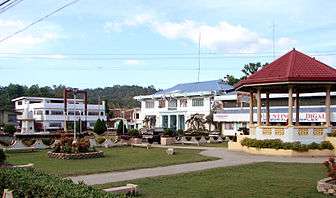Poblacion
 |
| This article is part of a series on the politics and government of the Philippines |
|
Legislature
|
|
Constitutional Commissions |

Poblacion or población (literally "town" or "population"[1] in Spanish) is the name commonly used for the central, downtown, or central business district area of a Philippine city or municipality, which may take up the area of a single barangay or multiple barangays. It is sometimes shortened to "Pob."
History
During the Spanish rule, the colonial government adopted the Reducción policy. This resettlement process coerced inhabitants of far-flung scattered ancient barangays to move into a centralized cabecera (town/district capital) where a newly built church was situated.[2] This allowed the Spanish government to control the movement of the indigenous population, to easily facilitate Christianization, to conduct population counts, and to collect tributes.
Features
The población is considered the commercial and industrial centre of the city or municipality. Most citizens of a city or municipality residing in the outlying barangays and satellite sitios flock to the población on market days (which is set by a local ordinance of the local government) because most local products and goods from the barrios are brought to the public market located in the población. In this way, their products could be sold faster by a wide range of buyers, though there are instances where some citizens would choose to go to another town's poblacion because it is closer to their residence.
The cabecera (or the población of a municipio/pueblo) has a basic plan, with a plaza mayor, church and attached convento, civic buildings such as the town hall, and houses of prominent Spaniards.[3][4][5] Other features include the public market, the central elementary school and high school.[6]
See also
References
- ↑ Google Translate : Spanish to English - "poblacion"
- ↑ Constantino, Renato; Constantino, Letizia R. (1975). "Chapter V - The Colonial Landscape". The Philippines: A Past Revisited (Vol. I) (Sixteenth Printing (January 1998) ed.). Manila, Philippines: Renato Constantino. pp. 60–61. ISBN 971-895-800-2. Retrieved 18 January 2015.
- ↑ Abinales, Patricio N.; Amoroso, Donna J. (2005). "New States and Reorientations 1368-1764". State and Society in the Philippines. Lanham, Md.: Rowman & Littlefield. pp. 53, 55. ISBN 0742510247. Retrieved 15 January 2015.
- ↑ Alas, José Mario “Pepe”. "28 July 1571: The Foundation Date of the Province of La Laguna". Academia.edu. Retrieved 15 January 2015.
- ↑ "The Philippines Then and Now; Spanish Period". Blogspot. 22 May 2009. Retrieved 15 January 2015.
- ↑ Halili, Christine N. (2004). Philippine History. Manila: Rex Book Store. p. 86. ISBN 9712339343. Retrieved 11 October 2014.
